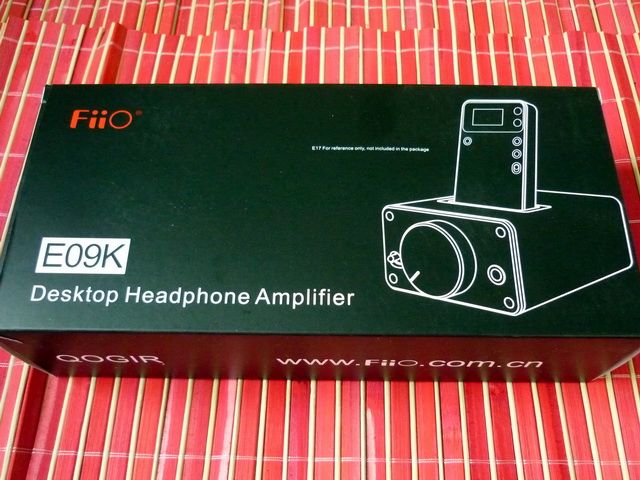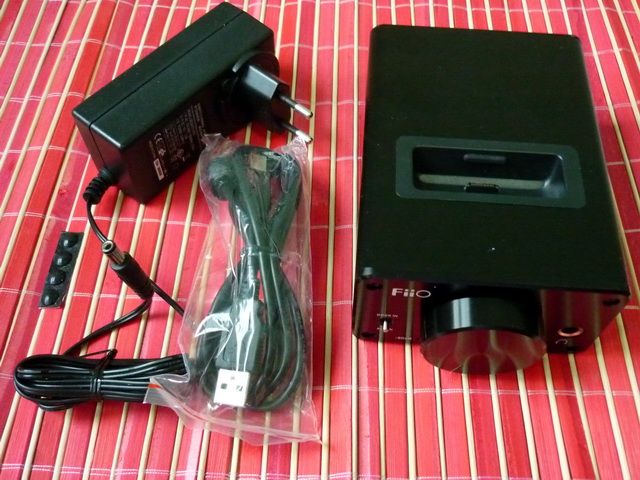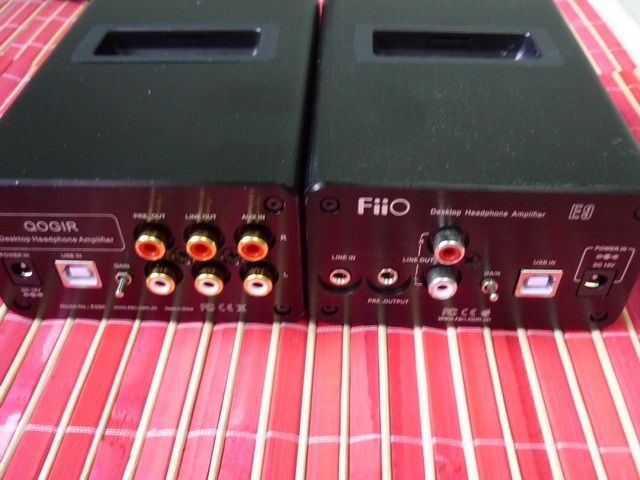
SPEC
Output power:
≥900mW (32Ω Loaded)
≥150mW (300Ω Loaded)
Headphone Impedance Range: 16Ω ~ 600Ω
SNR: ≥100dB(A weight) [via AUX IN]
Distortion: under 0.003%
Frequency response: 20Hz~20KHz
Fixed line out: under 2v
Adjustable Pre-out: 0~6V rms
Power supply : DC15V 1.5A
Size: 149mm×96mm×56mm
Weight: 440g
Price: USD$120

Build Quality and Accessories
Overall, the build quality is similar to the E9, which is quite solid to say the least. Then again, most FiiO stuffs are generally quite solid for the price. Accessories wise, there isn’t that much to speak of. Beside the power adapter, all you got is an USB cable. Note that E09K, like E9, doesn’t have an USB DAC inside and thus will not work with a PC even if you connected them together. That is where E17 comes in – but we will visit this topic at a later time.
The main exterior changes from E9 to E09K including the remove of the 3.5mm stereo jack, replaced by a front selection switch to choose between AUX-in or Dock-in (for E17). On the back, some of the connections and switches get rearranged. Basically all the 3.5mm jacks on the back were replaced by RCA jacks instead. Function wise however, I’ll expect them to perform just the same.

Front: Dock-in/USB-in selection, volume / power, 6.5mm jack.

Back: Power-in, USB-in, gain switch, Pre-amp out, line-out and AUX-in
Extra Features
One of the first and major differences between E9 and E09K is that E09K will not support E7 docking. As one of the extra feature added to the E09K, now the volume pot not only turns E09K on, but also E17 at the same time. This mean you won’t have to turn on or shutdown them separately. However, the tighter integration causes the older E7 to behave strangely with a big volume drop on one side. However, FiiO does intend to add the sync power switch function to the upcoming reversion of E7, the E07K. Until then, E17 will be the only USB DAC that can take benefit of the FiiO dock connector on top of E09K.
Beside the sync power switch, another big change is the cancellation of the 3.5mm jack. It might see unorthodox to remove the more common 3.5mm jack and instead leave only the 6.3mm jack behind, but it is for good reason. The original E9 wasn’t really designed for easy-to-drive small headphone in mind, but out of convenience the 3.5mm was included. The TPA6120 headphone amp chip inside E9 has a bit too much power and requires minimum 10 ohm output impedance for stability. To make it to work with more sensitive small headphone and especially IEM, FiiO has to add another 33ohm to the 3.5mm jack. All and all, it works but not in ideal condition and has received some criticism. It turns out most user still end up using the 6.3mm jack with an adapter anyway. The decision to remove the 3.5mm jack on the new design is rather a gesture for FiiO to put this issue to rest – now we know E09K is for full-sized headphone that are more difficult to drive. We will discuss more on this on the next section.

Front: E09K (left) vs. E9 (right)

Back: E09K (left) vs. E9 (right)
SQ
As I have said in my E17 review, the original E9 and E17 is roughly on par when it comes to SQ with pros and cons of their own. E17 has better soundstage and detail, while E9 offers tighter control and impact on bass with a more resolved lower vocal. Both has the trademark FiiO house sound which is neutral on frequency response but with a splash of warmness. As far as internal circuit design is concerned, E9 and E09K should be almost identical but with different PCB layout. FiiO doesn’t claim to have improved the SQ, which I think it is fair. I have measured both using RMAA and overall, the results out of the 6.5mm jack with a 150ohm load are close to identical. The only difference is that E09K has slightly better crosstalk (5dB better). It isn’t much, but I do notice E09K indeed sounds slightly more specious during volume matched A/B’ing. Otherwise, I have to say they two are very close in performance.
Much like E9, E09K is also on par with E17 sound quality wise. I have said this in the E17 review and I’ll repeat it again - if you are using anything below 150ohm, E17 alone is enough. This is especially true to multi-way IEM which often requires very low output impedance to avoid coloration (and thus a good thing to remove the high output impedance 3.5mm jack from the original design). If you are using anything beyond 300ohm, E09K make better sense. For those in between, I think both can work out well (in different way) depend on how you like to take your music. Essentially, if you are a PC user, E17 will cover most of the easy-to-driver headphone to something slightly more demanding. But if you are using a 600ohm Beyer, you will probably be better off with E17 as USB DAC feeding the E09K and then to the headphone. With both, you pretty much cover all type of headphones except for the most power hunger.

E17+E09K
Ending
Like most of FiiO’s product line-up, the strong point of E09K is in its value-for money factor. It isn’t that best sounding headphone amp out there, but there simply isn’t that many other competitors in the same price bucket. Like the previous model it has replaced, E09K will serve as a excellent entry level option for those who are in tight budget and want some solid power for demanding headphone.





